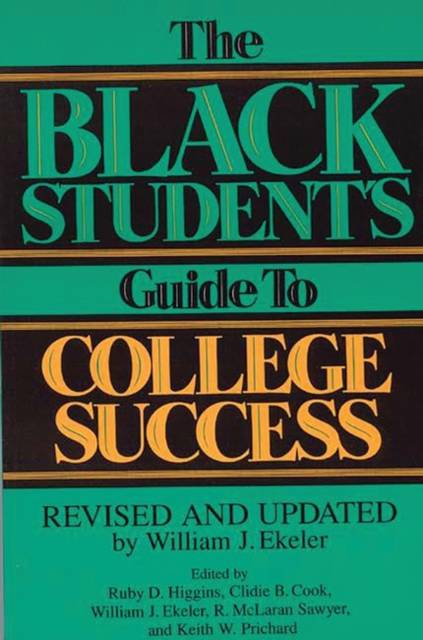
- Retrait gratuit dans votre magasin Club
- 7.000.000 titres dans notre catalogue
- Payer en toute sécurité
- Toujours un magasin près de chez vous
- Retrait gratuit dans votre magasin Club
- 7.000.0000 titres dans notre catalogue
- Payer en toute sécurité
- Toujours un magasin près de chez vous
The Black Student's Guide to College Success
Revised and Updated by William J. Ekeler
Ruby D Higgin, R McLaran SawyerDescription
The book begins with a step-by-step guide to a successful college selection process and freshman year, offering insights invaluable to students, parents, teachers, guidance counselors, and athletic recruiters. Next, notable African-American men and women tell the stories of their own college careers--from admission to graduation--in 27 short, autobiographical essays included in Part Two of the book, How I Did It. Also featured is a directory of more than 900 colleges and universities with information and statistics of particular interest to African-American students. The directory includes evaluations and listings of the most prestigious American undergraduate institutions, with detailed information on special programs and activities for African-American students, entries on historically Black U.S. colleges and universities and African and Caribbean institutions, and information on Black Greek letter organizations. A subject index concludes the guide.
This is the only complete college guide specifically designed for African-American students and their counselors. The Black Student's Guide to College Success is a step-by-step quide and reference tool for students, parents, teachers, guidance counselors, and athletic recruiters--leading the reader through a successful college selection process and freshman year. A directory of more than 900 colleges and universities is provided, with information of particular interest to African-American students. Many distinguished Black educators and prominent Americans have contributed to make this work a comprehensive reference tool which addresses the questions and problems encountered by African-American students. A foreword by Dr. Louis W. Sullivan, former U.S. Secretary of Health and Human Services, introduces the first part, How to Succeed in College, featuring 14 hard-hitting essays geared to the needs of the African-American student during the college selection process and the freshman year. Of special interest are: * essays on the Black student athlete; * choosing a Black or an integrated college; * financing a college education; * connecting with students from Africa and the Caribbean; * getting along with other ethnic groups on campus; * handling academic stress; * study habits and hints; and * affirmative action. The next part, How I Did It, includes inspirational autobiographical essays on the college careers--from admission to graduation--of 27 notable African-American men and women. These success stories will motivate and encourage students as they consider their college options. The last part, Directory of Colleges and Universities, includes: (1) complete up-to-date information on more than 900 American colleges and universities (2) the names of recruiters of African-American students (3) the percentage of African-American students enrolled and those who graduate (4) the percentage of student athletes who graduate, and (5) information on African-American organizations Evaluations and listings of the most prestigious U.S. undergraduate institutions, detailed information on programs and activities of special interest to African-American students, listings of historically Black colleges and universities (and evaluations of the top ten), profiles of universities in Africa and the Caribbean, and information on national Black Greek letter organizations are also included in this thorough, accessible directory. A subject index concludes the guide. This work is especially useful for high school and public libraries, high school guidance and career counselors, college admissions offices, athletic recruiters, and African-American education organizations, as well as for aspiring African-American students in search of the motivational key to achievement in college.Spécifications
Parties prenantes
- Auteur(s) :
- Editeur:
Contenu
- Nombre de pages :
- 392
- Langue:
- Anglais
Caractéristiques
- EAN:
- 9780313294310
- Date de parution :
- 30-11-94
- Format:
- Livre relié
- Format numérique:
- Genaaid
- Dimensions :
- 163 mm x 244 mm
- Poids :
- 730 g

Les avis
Nous publions uniquement les avis qui respectent les conditions requises. Consultez nos conditions pour les avis.






